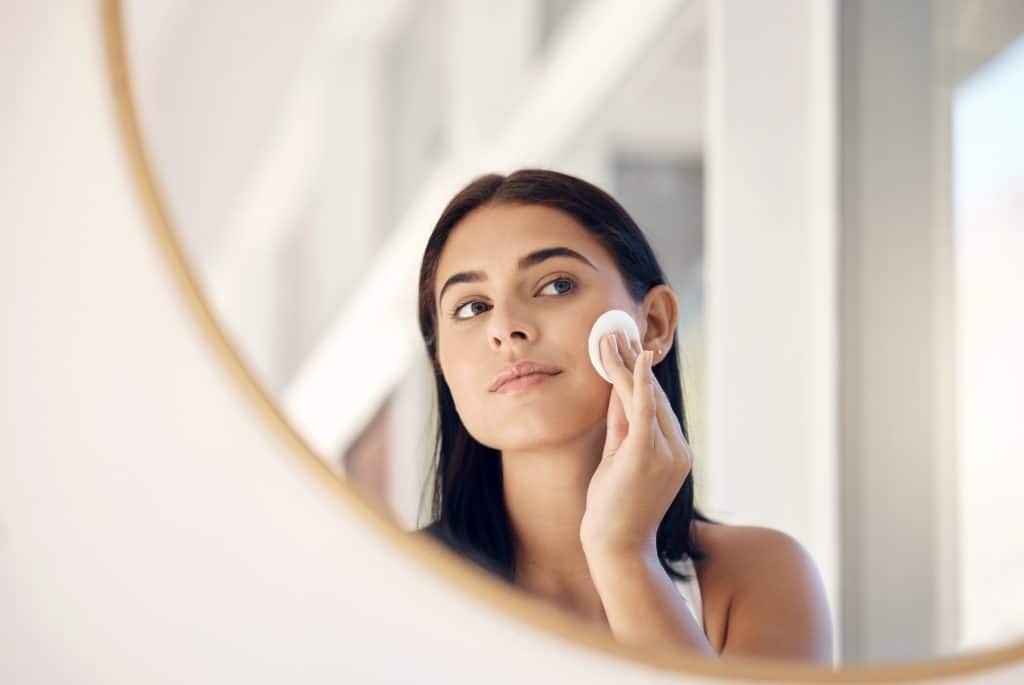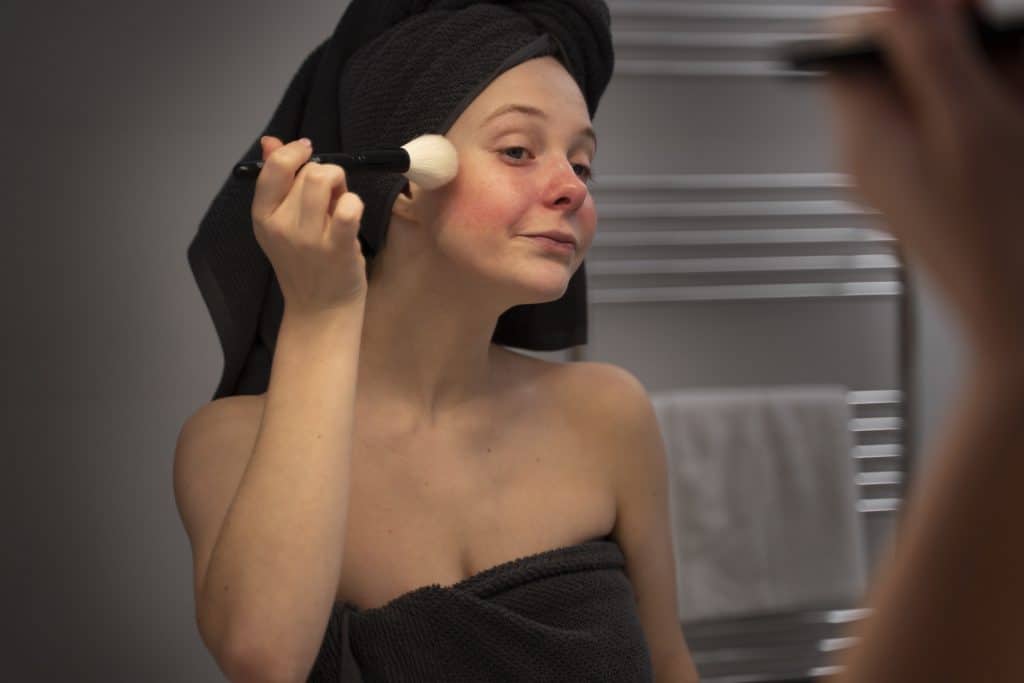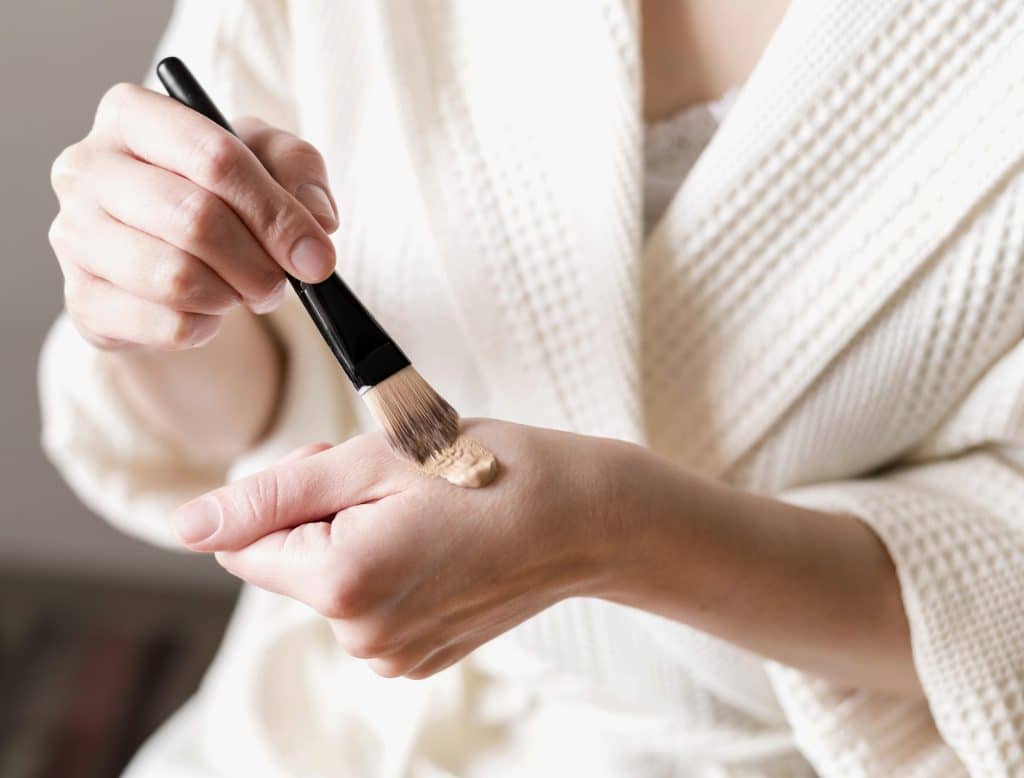Oily Skin Solutions: Control Shine and Prevent Acne

Advertisements
Achieving healthy, balanced skin can be a transformative experience for those with oily skin. It significantly improves both appearance and confidence.
For many, the quest for a clear, balanced complexion free from persistent shine can feel like an unending journey. The constant battle against excess sebum often leads individuals to seek countless products.
Advertisements
This article provides a path to healthier, more radiant skin. It’s an oily skin breakthrough, offering an updated routine to control shine and prevent breakouts.
Understanding oily skin: causes and challenges
Oily skin is characterized by an overproduction of sebum. While sebum is essential, an excess leads to a shiny appearance, enlarged pores, and a predisposition to acne.
Advertisements
The science behind this is a complex interplay of genetic, hormonal, and environmental factors. Hormonal fluctuations and genetics are key influencers of sebum production.
Beyond internal factors, external elements can exacerbate the problem. It’s crucial to understand these causes for effective management.
The science behind sebum production
Sebum production is influenced by genetic, hormonal, and environmental factors. Hormonal fluctuations, particularly androgens, play a significant role.
Genetics also dictate an individual’s predisposition to oiliness. If your parents have oily skin, chances are you might too.
Beyond these internal factors, external elements can exacerbate the problem. Hot and humid environments can stimulate sebum production.
Common misconceptions about oily skin
A pervasive misconception is that oily skin doesn’t need moisturizer or that harsh cleansers are necessary. Excessively drying out the skin can trigger a rebound effect, producing even more oil.
Aggressively scrubbing the skin can also irritate it. This can lead to inflammation and more breakouts. It is crucial to approach oily skin with care, focusing on balance.
Another mistake is attributing all oiliness to diet. While some foods might exacerbate inflammation, the link to increased sebum production is not definitive.
The updated routine: essential steps for shine control
Developing an effective skincare routine for oily skin involves a multi-faceted approach. It balances cleansing, treatment, and hydration without over-stripping.
The goal is to regulate sebum production while addressing concerns like enlarged pores. A targeted regimen can lead to a more balanced complexion.
This routine focuses on consistent, gentle care. It’s designed to help you achieve long-term control over shine and breakouts.
Gentle cleansing: the foundation
Forget harsh, drying cleansers that leave your skin feeling ‘squeaky clean’. For oily skin, a gentle, foaming or gel cleanser is ideal.
Cleansing twice daily, morning and night, is essential. This removes excess oil, makeup, dirt, and pollutants that gather throughout the day.
Over-cleansing can be counterproductive, signaling your skin to produce even more oil. Stick to twice a day, using lukewarm water and gently patting your face dry.

Targeted treatments: salicylic acid and niacinamide
Once your skin is clean, targeted treatments can address specific concerns. Salicylic acid is a hero ingredient for oily skin because it’s oil-soluble.
It can penetrate through sebum and exfoliate inside the pores. This helps dissolve dead skin cells and excess oil, preventing clogs.
Niacinamide is another powerhouse ingredient. It helps regulate sebum production, minimize pore appearance, and boasts anti-inflammatory properties to calm redness.
Lightweight hydration: moisturizer is a must
One of the biggest mistakes people with oily skin make is skipping moisturizer. Fear of adding more oil leads to dehydrated skin, which then produces more oil.
The key is to choose the right kind of moisturizer: a lightweight, non-comedogenic formula. Look for gel-based or oil-free options.
Apply a thin layer both morning and night. This step is crucial for achieving long-term shine control and preventing future breakouts.
Beyond the basics: advanced strategies for lasting results
While the core steps form the bedrock of an effective routine, advanced strategies can provide additional benefits. These focus on deeper exfoliation, protection, and long-term maintenance.
Exfoliation is vital for oily skin, as it removes dead skin cells that clog pores. Both chemical and physical exfoliants can be used.
Sun protection is non-negotiable for all skin types. Lightweight, non-comedogenic sunscreens are now available for oily skin.
Exfoliation: chemical vs. physical
Exfoliation is vital for oily skin. Physical exfoliants, like scrubs, should be used sparingly and gently, no more than once a week.
Chemical exfoliants, such as AHAs and BHAs, are generally more effective and gentler. They dissolve the bonds between dead skin cells and promote cell turnover.
Incorporating an AHA toner or serum 2-3 times a week, alternating with BHA products, can provide comprehensive exfoliation. This approach avoids inflammation while effectively resurfacing the skin.
Sun protection: non-negotiable for all skin types
Sun protection is paramount, even for oily skin. UV radiation can damage skin cells and exacerbate post-inflammatory hyperpigmentation.
Many people with oily skin avoid sunscreen, but there are now elegant, oil-free, non-comedogenic formulas. Look for gel-based or fluid formulas with a matte finish.
Mineral sunscreens with zinc oxide can also be excellent. This protects your skin from harmful UV rays and contributes to a healthier complexion.

Masks and treatments: weekly boosts
Incorporating weekly masks can provide an extra boost. Clay masks are excellent for drawing out impurities and absorbing excess oil from pores.
Use them once or twice a week to purify and detoxify your skin. A charcoal mask can also absorb toxins.
For targeted breakout relief, a sulfur mask is highly effective. These are not substitutes for daily care but powerful additions for sustained control.
Lifestyle adjustments: supporting your skin from within
While topical skincare is crucial, holistic well-being plays a massive role in skin health. Lifestyle adjustments can significantly support your oily skin breakthrough.
These practices address internal factors that influence skin condition. Stress and diet can both have a tangible impact on sebum production.
A calm approach to clear skin, supported by a healthy diet and proper hydration, can make a significant difference in long-term results.
Diet and hydration: fact vs. fiction
The link between diet and oily skin is debated, but a diet rich in whole foods, antioxidants, and omega-3s can support skin health. Processed foods and excessive dairy have been linked to exacerbating acne.
Adequate hydration is also essential. Drinking plenty of water helps maintain skin’s elasticity and overall health. Dehydrated skin can compensate by producing more oil.
Focus on a balanced, nutrient-dense diet and consistent water intake. This simple yet effective step supports your skincare routine.
Stress management: a calm approach to clear skin
Stress isn’t just mental; it has tangible physiological effects on the body. When stressed, the body releases cortisol, a hormone that can stimulate sebaceous glands to produce more oil.
This can lead to increased oiliness and exacerbate breakouts. Incorporating stress management techniques can indirectly benefit your skin health.
Adequate sleep is also a critical component of stress management. A calmer mind often translates to calmer skin, showing that taking care of your mental well-being is integral to an effective routine.
Common pitfalls to avoid with oily skin
Navigating the nuances of oily skin can be tricky. Many people inadvertently make choices that hinder their progress. Avoiding these pitfalls is as important as implementing the right steps.
One of the most frequent mistakes is using harsh cleansers, toners with high alcohol content, or scrubbing too vigorously. These actions strip the skin of its natural protective barrier.
The goal is to balance oil production, not eliminate it. A gentle routine followed by appropriate hydration maintains this delicate balance and prevents the skin from overcompensating.
Over-stripping the skin
One of the most frequent mistakes is using harsh cleansers that leave skin feeling ‘squeaky clean’. This can be misinterpreted as effectiveness.
In reality, these actions strip the skin of its natural barrier, leading to dehydration. The skin then goes into overdrive to produce more sebum, perpetuating the cycle.
Always opt for gentle, pH-balanced products. If your skin feels tight or irritated after washing, your cleanser is likely too harsh.
Ignoring the importance of non-comedogenic products
For individuals with oily and acne-prone skin, every product applied to the face should be non-comedogenic. This term means the product is formulated not to clog pores.
Skipping this crucial consideration can negate all other efforts in your routine. Makeup, sunscreen, and moisturizers can contain ingredients that trigger breakouts.
Checking product labels for the “non-comedogenic” claim is a simple yet powerful step. This vigilance ensures your products actively prevent breakouts.
The long-term benefits of an updated routine
Implementing an updated, consistent skincare routine is an investment in long-term skin health. The benefits extend far beyond simply controlling shine and preventing breakouts.
It leads to a more resilient and radiant complexion over time. Consistent use of the right products leads to a noticeable improvement in skin texture and clarity.
This visible transformation is a powerful testament to product consistency. It can naturally boost self-esteem and reduce reliance on heavy makeup.
Improved skin texture and clarity
Consistent use of the right products leads to a noticeable improvement in skin texture. By preventing dead skin cells and excess oil from accumulating, skin becomes smoother.
Enlarged pores often appear smaller as they are no longer stretched by blockages. This contributes to overall skin clarity, reducing blackheads and blemishes.
Over time, the reduction in active breakouts means fewer instances of dark spots and scarring. The routine focuses on prevention rather than reactive treatment.
Reduced inflammation and sensitivity
Oily skin, especially when acne-prone, can be characterized by underlying inflammation. Harsh treatments only exacerbate this sensitivity.
The updated routine emphasizes gentle cleansing and hydration, which helps to reduce redness and irritation. A balanced skin barrier is crucial for defending against environmental aggressors.
By fostering a healthy skin environment, this approach makes skin more resilient. This reduction in chronic inflammation prevents long-term damage, showcasing a true oily skin breakthrough.
| Key Point | Brief Description |
|---|---|
| ✨ Gentle Cleansing | Use mild, non-stripping cleansers twice daily to remove excess oil without irritation. |
| 🔬 Targeted Treatments | Incorporate salicylic acid and niacinamide to regulate sebum and minimize pores. |
| 💧 Lightweight Hydration | Always use a non-comedogenic, oil-free moisturizer to prevent compensatory oil production. |
| ☀️ Daily SPF | Apply broad-spectrum, matte-finish sunscreen daily to protect against UV damage and dark spots. |
frequently asked questions about oily skin
While diet’s direct impact on sebum production is still being researched, some individuals report that highly processed foods, excessive sugar, and dairy might worsen their prone to acne conditions. Focusing on a balanced diet rich in fruits, vegetables, and lean proteins is generally beneficial for overall skin health, supporting a clearer complexion.
Absolutely. Skipping moisturizer can sometimes trigger your skin to produce even more sebum to compensate for dryness or dehydration. The key is to use a lightweight, non-comedogenic, and oil-free moisturizer. Look for gel-based formulas or those containing hyaluronic acid, which hydrate without adding excess oil or clogging pores.
For oily skin, chemical exfoliants like salicylic acid (BHA) or glycolic acid (AHA) are often preferred over harsh physical scrubs. Start with 2-3 times a week, observing how your skin responds. Over-exfoliating can lead to irritation and increased oil production, so it’s best to be gentle and gradual with frequency.
Look for ingredients like salicylic acid (BHA) for pore exfoliation, niacinamide for oil control and minimizing pore appearance, hyaluronic acid for lightweight hydration, and clay (like bentonite or kaolin) for oil absorption in masks. Ensure all products are labeled “non-comedogenic” to prevent clogged pores and breakouts.
Yes, stress can definitely impact oily skin. When you’re stressed, your body produces more cortisol, a hormone that can stimulate your sebaceous glands to produce more oil. Managing stress through practices like meditation, exercise, and adequate sleep can therefore contribute positively to maintaining a balanced complexion.
conclusion
Achieving a significant oily skin breakthrough is an attainable goal with the right approach. By understanding the unique needs of oily skin and committing to a consistent, updated routine that blends gentle cleansing with targeted treatments and lightweight hydration, individuals can effectively control shine and prevent breakouts.
Combined with mindful lifestyle adjustments and an awareness of common pitfalls, this holistic strategy paves the way for a clearer, healthier, and more confident complexion. Patience and consistency are your greatest allies in this journey towards lasting skin balance.





